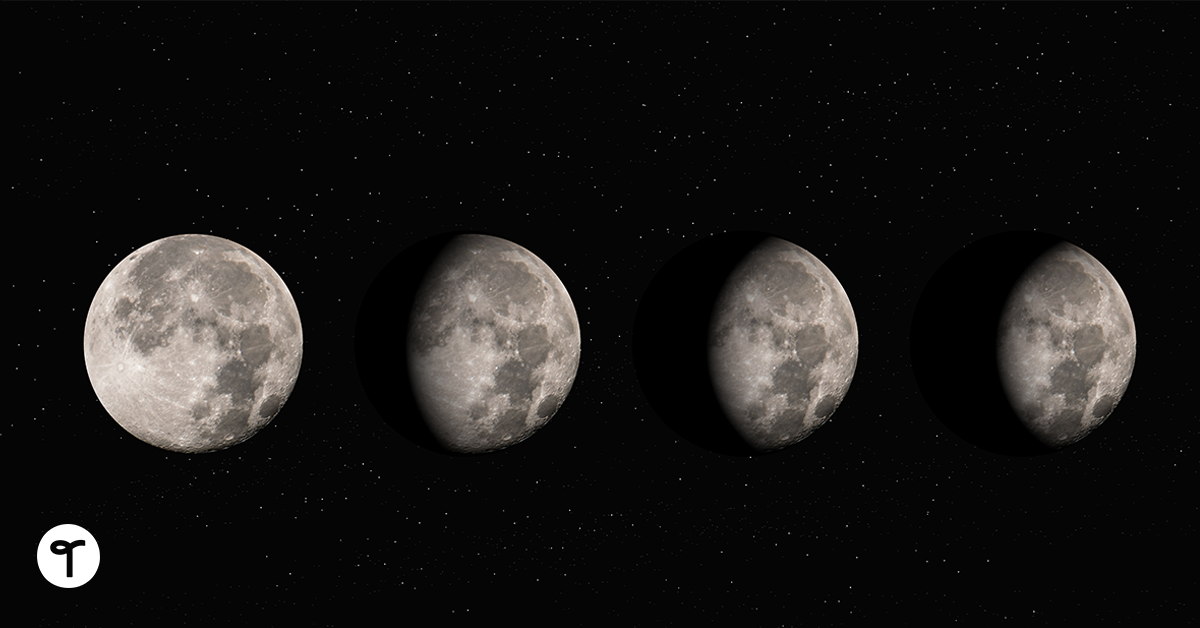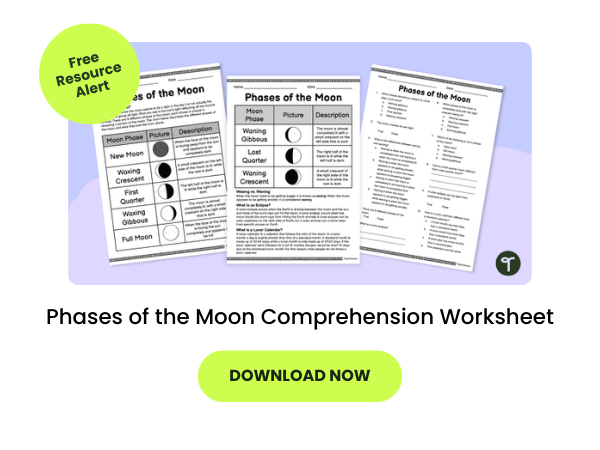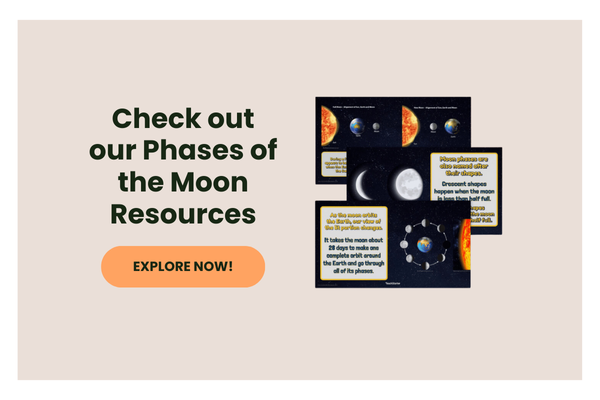While we call Earth home, the moon plays a vital role in our existence. These 25 fun facts about the moon will help students of any age learn about it and intrigue them about the world around us.
The teacher team at Teach Starter has developed a list of interesting moon facts to include in your science and space lesson plans—and even a pop quiz or two! From how the moon was created to understanding its phases, there is a heap of knowledge and trivia to inspire your class. We’ve also included a few of our teacher team’s favourite ways to weave these fun facts into lesson planning.
Fun Facts About The Moon For Kids
1. That small orb of light in the night sky that we know as the moon is around 3480 km in diameter. That is roughly a quarter the size of the Earth!
2. Although the moon appears to glow brightly, its surface is dark. This is because the moon reflects light from the sun, just like the Earth.
3. The moon’s surface is covered in huge craters caused by asteroids and comets crashing into the surface.
4. Hardened ‘lunar lava’ plains cover the moon’s surface from volcanic eruptions billions of years ago.
5. The moon has its own mountain! The tallest mountain is Mons Huygens, which is around 5000 metres tall—slightly more than half the size of Mt. Everest!
6. Although the moon looks quite close to the Earth, it is actually 384 400 km away – about 45 times as long as The Great Wall of China!
7. You might have noticed that the moon and sun look about the same size, but the moon is actually 400 times smaller! However, the moon is also 400 times closer than the sun to the Earth, which makes the two planets look the same size. How interesting!
8. The moon rotates around the Earth, known as an orbit. It takes 27.3 days for the moon to complete its orbit – almost one month!
Discover a world of printable moon and space resources and activities!
9. The moon is the Earth’s only permanent natural satellite. It is known as a satellite because it rotates around the Earth, just like the Earth moves around the sun.
10. As the moon finishes its orbit, it rotates on an axis. This rotation takes the same time (27.3 days) as it does to orbit, so we only ever see about 60% of the moon’s surface.
11. Each year, the moon drifts approximately 3.8 cm away from the Earth.
12. Have you ever wondered how the moon was created? A common theory is that more than 4 billion years ago, a smaller planet in the solar system plummeted into the Earth, causing debris to float around the Earth. This debris eventually formed a round, rough rock known as the moon.
13. Traces of water have been found on the moon stuck to dust particles and grains!
14. The moon has gravity, just like Earth. However, it is weaker than the gravity that keeps our feet solidly planted on the ground. So, it would be very bouncy on the moon!

15. Did you know that the moon experiences earthquakes, too? They’re called ‘moonquakes’ and are typically weaker than Earthquakes but can last up to an hour! Moonquakes are caused by meteoroids colliding with Earth’s gravitational pull.
16. Unlike the fresh air we breathe on our planet, there is not enough oxygen on the moon for humans to live. Planning to visit one day? Pack a spacesuit and helmet!
17. The moon affects ocean tides on Earth! This is because of the moon’s gravitational pull on Earth’s ocean levels, creating high tides and low tides.
18. Unlike Jupiter, Saturn, Uranus and Neptune, the moon has no rings.
19. Ever noticed that the moon looks big and round one week but then only a semi-circle shape the next? These are called phases of the moon. As the moon rotates on its axis (while getting its light source from the sun), varying angles of the moon receive sunlight at different times, causing the moon to appear as though it is changing shape.
20. A full moon occurs when a whole side of the moon is illuminated by the sun and can be seen from Earth. On average, there is one full moon each month!
21. The moon has extreme temperature changes! When the sun shines on its surface, temperatures can soar to 120°C but drop to a chilly -130°C at night.
22. American astronaut Neil Armstrong was the first person to ‘walk’ on the moon as part of NASA’s Apollo 11 mission in 1969.
23. There is no breeze or rain on the moon. So, the footprints left by astronauts from Apollo 11 are still on the moon’s surface today!
24. A lunar eclipse happens when the sun, Earth and moon are aligned in orbit. During a lunar eclipse, the Earth blocks the sun from shining on the moon, causing it to be in shadow.
25. Although the moon does look like a tasty block of cheese, it is actually made of a combination of minerals including magnesium, silicon and iron.
How to Use These Fun Facts in Your Classroom
Want to incorporate these moon facts in your classroom activities? We asked our teacher team for some fun and easy ways to get your students reaching for the stars!
- Moon Phase Lesson. Spread your students around the classroom, and use a flashlight to shine a light on a round moon-shaped object, such as a basketball. By directing the light on the ball, students in different parts of the classroom can study ‘the moon’ and discuss the phases they see. Students in younger grades can also use playdough to create the different phases of the moon while developing their fine motor skills through sculpting.
- Quick Quiz Time. Turn these moon facts into flashcards with multiple-choice answers, and split your class into small groups to quiz their knowledge! This activity will assist your students with decision-making skills and memory function.
- Research Project. Let your students choose a fun fact to research further and present their findings to the rest of the class! They can explore their creativity by presenting their findings through a collage or poster to stick up in the classroom.









Comments